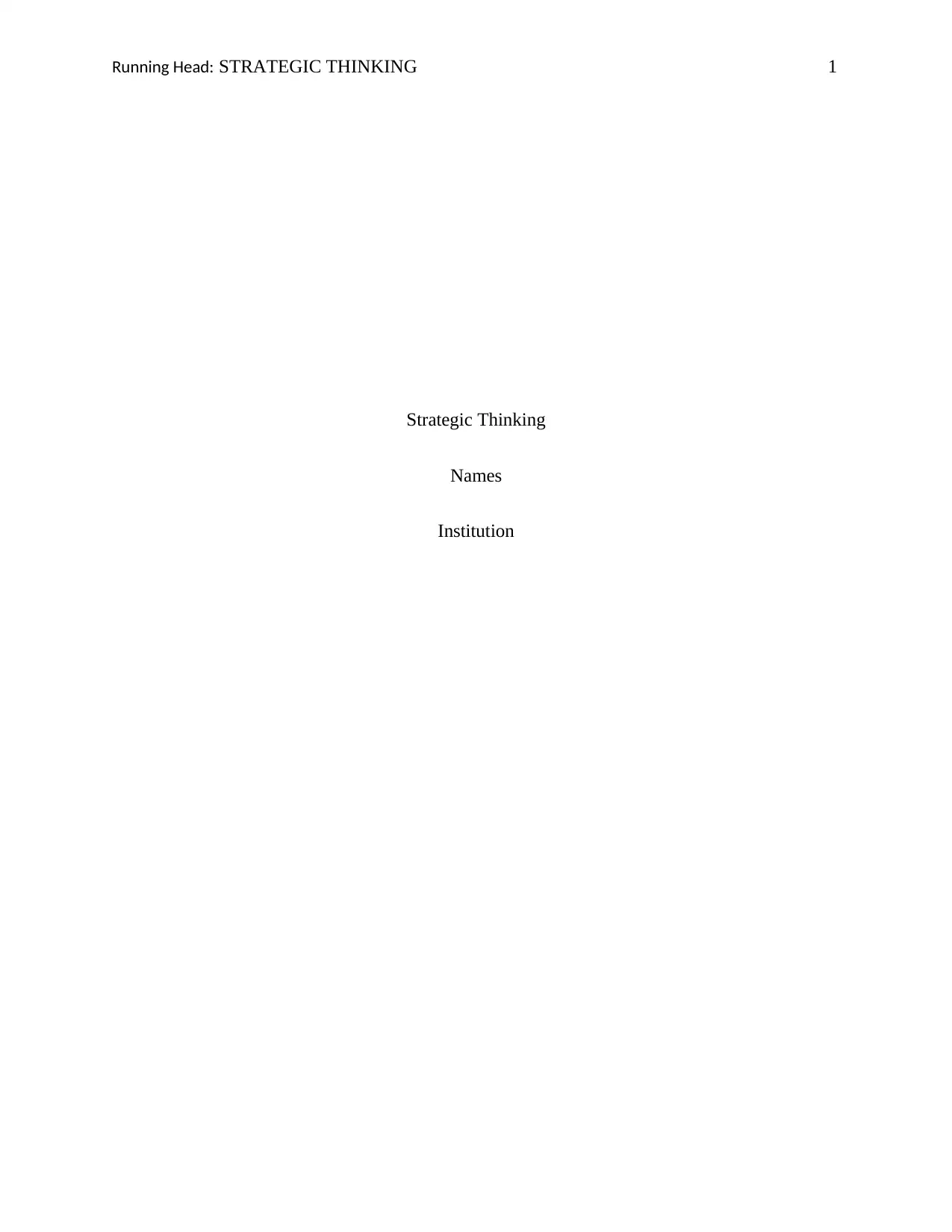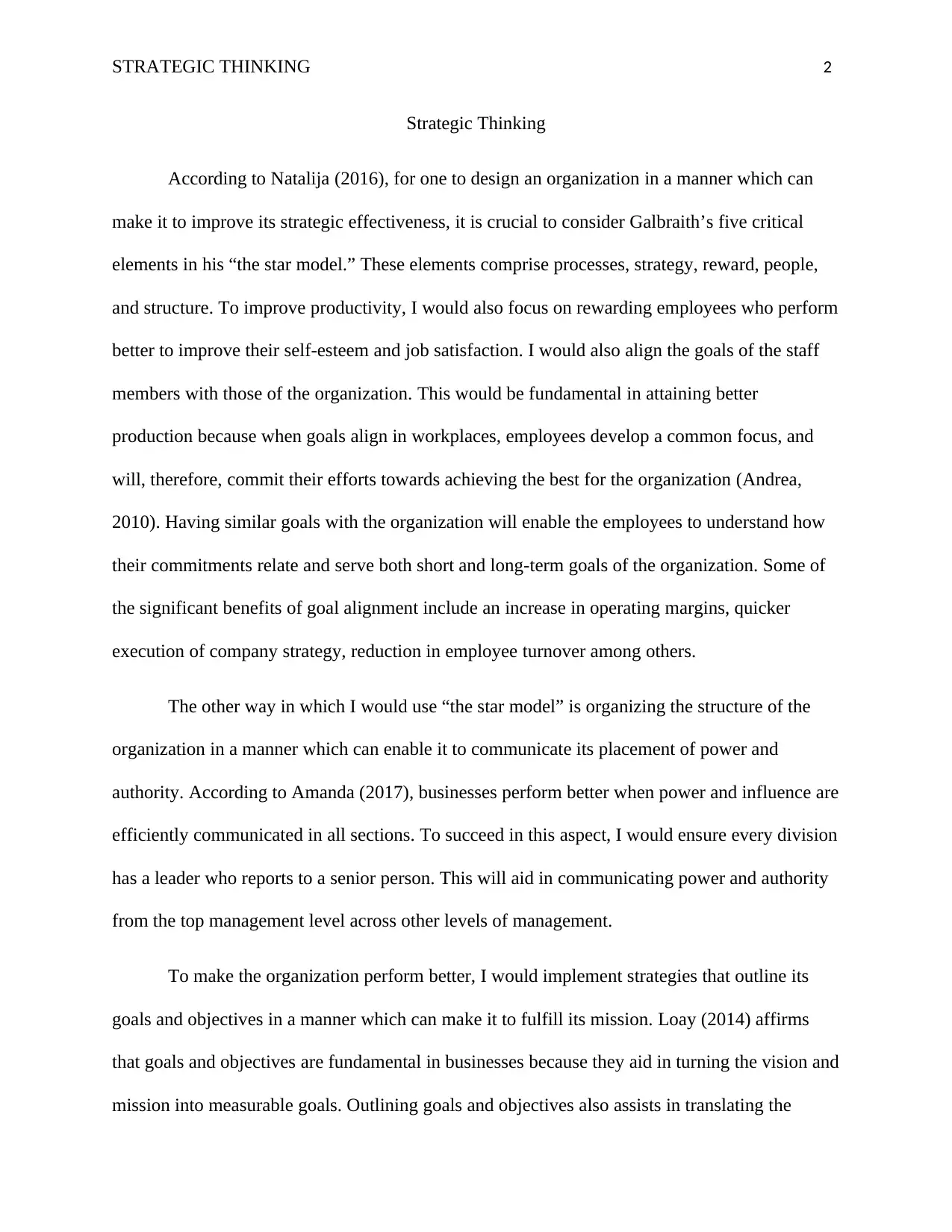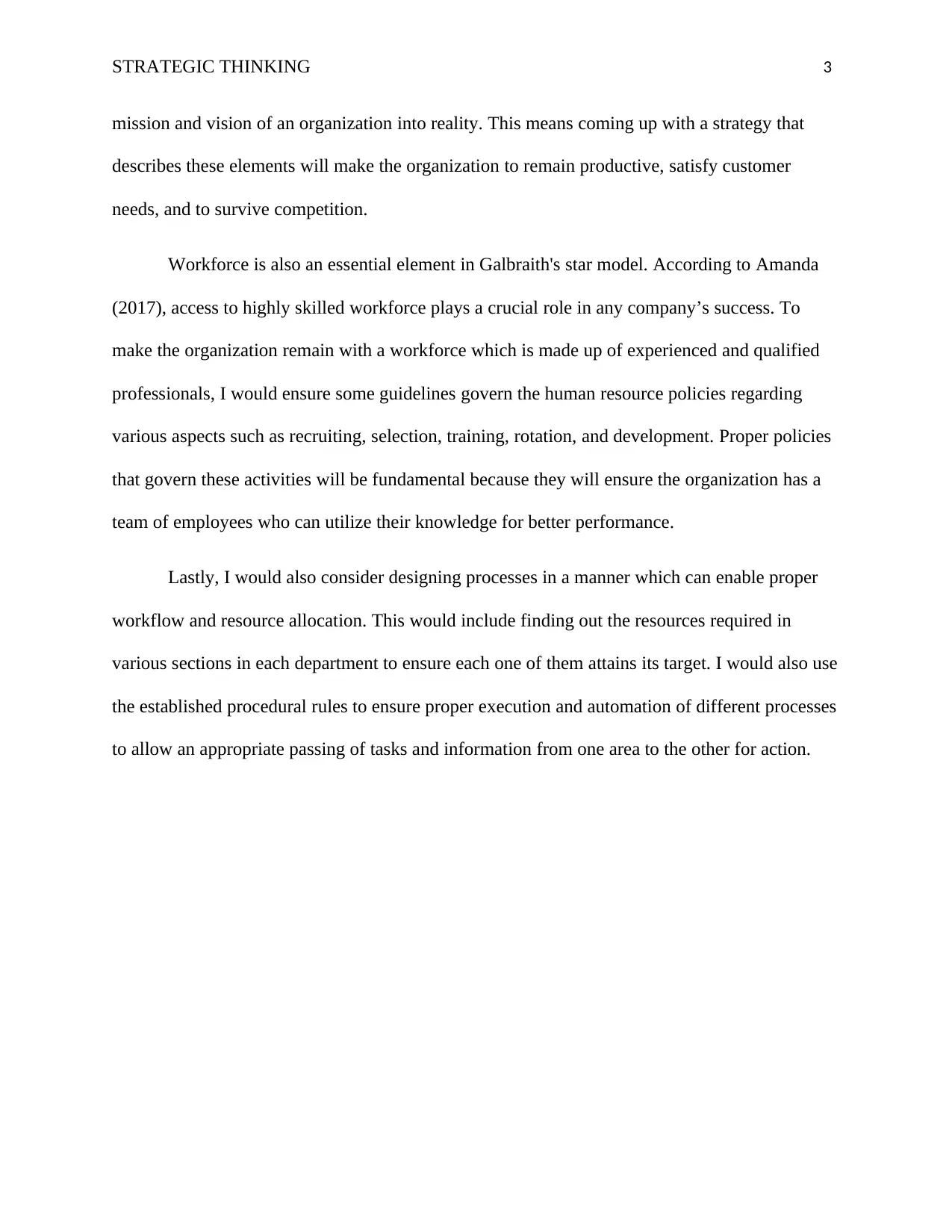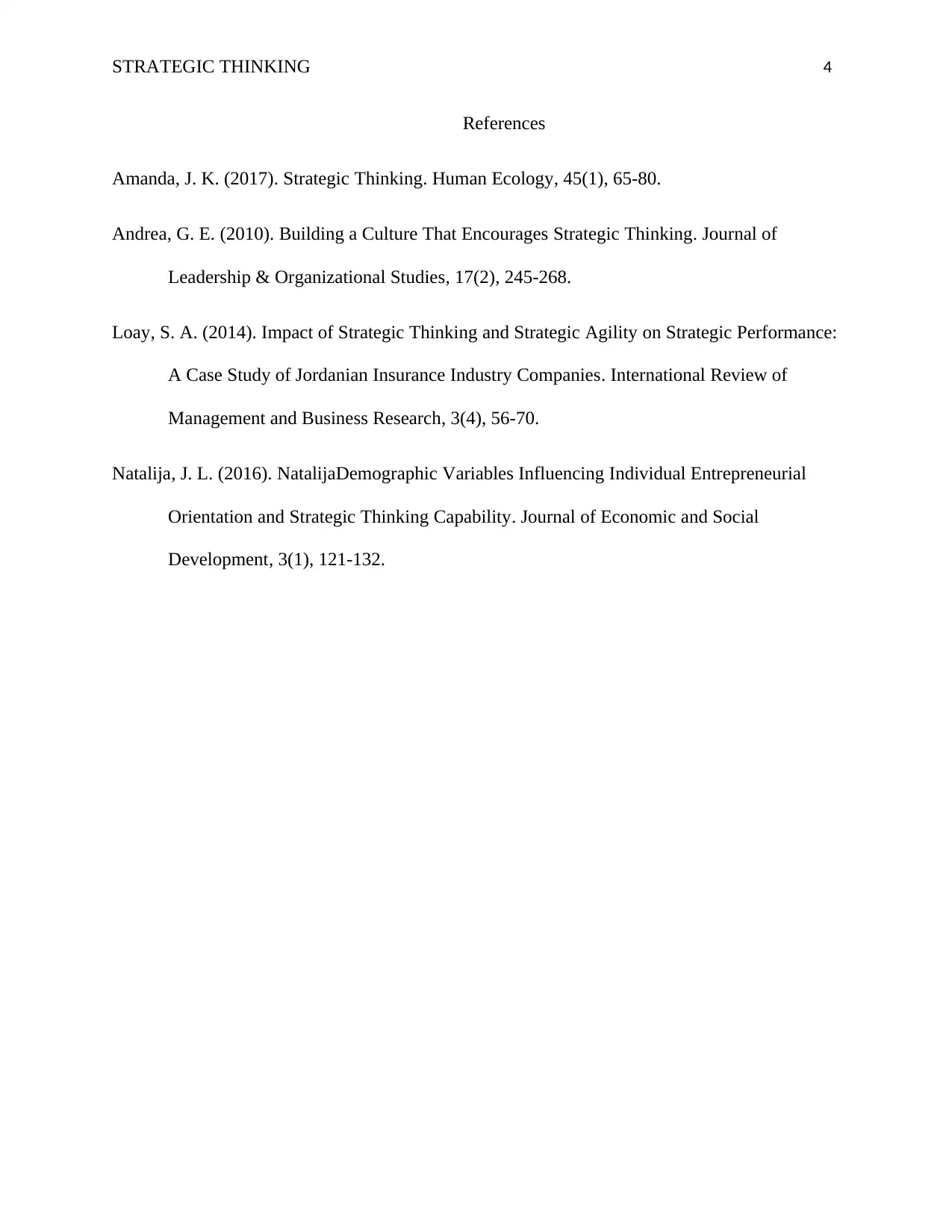Strategic Thinking: Applying Galbraith's Star Model for Productivity
VerifiedAdded on 2023/06/13
|4
|728
|351
Essay
AI Summary
This essay discusses the application of strategic thinking within organizations, focusing on Galbraith's Star Model, which includes strategy, structure, processes, rewards, and people. The solution emphasizes aligning employee goals with organizational objectives to enhance productivity, improve communication of power and authority through organizational structure, and implement strategies that turn the organization's mission into measurable goals. It also highlights the importance of a skilled workforce and well-designed processes for efficient resource allocation and workflow. The essay concludes by referencing several academic sources to support its arguments.

Running Head: STRATEGIC THINKING 1
Strategic Thinking
Names
Institution
Strategic Thinking
Names
Institution
Paraphrase This Document
Need a fresh take? Get an instant paraphrase of this document with our AI Paraphraser

STRATEGIC THINKING 2
Strategic Thinking
According to Natalija (2016), for one to design an organization in a manner which can
make it to improve its strategic effectiveness, it is crucial to consider Galbraith’s five critical
elements in his “the star model.” These elements comprise processes, strategy, reward, people,
and structure. To improve productivity, I would also focus on rewarding employees who perform
better to improve their self-esteem and job satisfaction. I would also align the goals of the staff
members with those of the organization. This would be fundamental in attaining better
production because when goals align in workplaces, employees develop a common focus, and
will, therefore, commit their efforts towards achieving the best for the organization (Andrea,
2010). Having similar goals with the organization will enable the employees to understand how
their commitments relate and serve both short and long-term goals of the organization. Some of
the significant benefits of goal alignment include an increase in operating margins, quicker
execution of company strategy, reduction in employee turnover among others.
The other way in which I would use “the star model” is organizing the structure of the
organization in a manner which can enable it to communicate its placement of power and
authority. According to Amanda (2017), businesses perform better when power and influence are
efficiently communicated in all sections. To succeed in this aspect, I would ensure every division
has a leader who reports to a senior person. This will aid in communicating power and authority
from the top management level across other levels of management.
To make the organization perform better, I would implement strategies that outline its
goals and objectives in a manner which can make it to fulfill its mission. Loay (2014) affirms
that goals and objectives are fundamental in businesses because they aid in turning the vision and
mission into measurable goals. Outlining goals and objectives also assists in translating the
Strategic Thinking
According to Natalija (2016), for one to design an organization in a manner which can
make it to improve its strategic effectiveness, it is crucial to consider Galbraith’s five critical
elements in his “the star model.” These elements comprise processes, strategy, reward, people,
and structure. To improve productivity, I would also focus on rewarding employees who perform
better to improve their self-esteem and job satisfaction. I would also align the goals of the staff
members with those of the organization. This would be fundamental in attaining better
production because when goals align in workplaces, employees develop a common focus, and
will, therefore, commit their efforts towards achieving the best for the organization (Andrea,
2010). Having similar goals with the organization will enable the employees to understand how
their commitments relate and serve both short and long-term goals of the organization. Some of
the significant benefits of goal alignment include an increase in operating margins, quicker
execution of company strategy, reduction in employee turnover among others.
The other way in which I would use “the star model” is organizing the structure of the
organization in a manner which can enable it to communicate its placement of power and
authority. According to Amanda (2017), businesses perform better when power and influence are
efficiently communicated in all sections. To succeed in this aspect, I would ensure every division
has a leader who reports to a senior person. This will aid in communicating power and authority
from the top management level across other levels of management.
To make the organization perform better, I would implement strategies that outline its
goals and objectives in a manner which can make it to fulfill its mission. Loay (2014) affirms
that goals and objectives are fundamental in businesses because they aid in turning the vision and
mission into measurable goals. Outlining goals and objectives also assists in translating the

STRATEGIC THINKING 3
mission and vision of an organization into reality. This means coming up with a strategy that
describes these elements will make the organization to remain productive, satisfy customer
needs, and to survive competition.
Workforce is also an essential element in Galbraith's star model. According to Amanda
(2017), access to highly skilled workforce plays a crucial role in any company’s success. To
make the organization remain with a workforce which is made up of experienced and qualified
professionals, I would ensure some guidelines govern the human resource policies regarding
various aspects such as recruiting, selection, training, rotation, and development. Proper policies
that govern these activities will be fundamental because they will ensure the organization has a
team of employees who can utilize their knowledge for better performance.
Lastly, I would also consider designing processes in a manner which can enable proper
workflow and resource allocation. This would include finding out the resources required in
various sections in each department to ensure each one of them attains its target. I would also use
the established procedural rules to ensure proper execution and automation of different processes
to allow an appropriate passing of tasks and information from one area to the other for action.
mission and vision of an organization into reality. This means coming up with a strategy that
describes these elements will make the organization to remain productive, satisfy customer
needs, and to survive competition.
Workforce is also an essential element in Galbraith's star model. According to Amanda
(2017), access to highly skilled workforce plays a crucial role in any company’s success. To
make the organization remain with a workforce which is made up of experienced and qualified
professionals, I would ensure some guidelines govern the human resource policies regarding
various aspects such as recruiting, selection, training, rotation, and development. Proper policies
that govern these activities will be fundamental because they will ensure the organization has a
team of employees who can utilize their knowledge for better performance.
Lastly, I would also consider designing processes in a manner which can enable proper
workflow and resource allocation. This would include finding out the resources required in
various sections in each department to ensure each one of them attains its target. I would also use
the established procedural rules to ensure proper execution and automation of different processes
to allow an appropriate passing of tasks and information from one area to the other for action.
⊘ This is a preview!⊘
Do you want full access?
Subscribe today to unlock all pages.

Trusted by 1+ million students worldwide

STRATEGIC THINKING 4
References
Amanda, J. K. (2017). Strategic Thinking. Human Ecology, 45(1), 65-80.
Andrea, G. E. (2010). Building a Culture That Encourages Strategic Thinking. Journal of
Leadership & Organizational Studies, 17(2), 245-268.
Loay, S. A. (2014). Impact of Strategic Thinking and Strategic Agility on Strategic Performance:
A Case Study of Jordanian Insurance Industry Companies. International Review of
Management and Business Research, 3(4), 56-70.
Natalija, J. L. (2016). NatalijaDemographic Variables Influencing Individual Entrepreneurial
Orientation and Strategic Thinking Capability. Journal of Economic and Social
Development, 3(1), 121-132.
References
Amanda, J. K. (2017). Strategic Thinking. Human Ecology, 45(1), 65-80.
Andrea, G. E. (2010). Building a Culture That Encourages Strategic Thinking. Journal of
Leadership & Organizational Studies, 17(2), 245-268.
Loay, S. A. (2014). Impact of Strategic Thinking and Strategic Agility on Strategic Performance:
A Case Study of Jordanian Insurance Industry Companies. International Review of
Management and Business Research, 3(4), 56-70.
Natalija, J. L. (2016). NatalijaDemographic Variables Influencing Individual Entrepreneurial
Orientation and Strategic Thinking Capability. Journal of Economic and Social
Development, 3(1), 121-132.
1 out of 4
Related Documents
Your All-in-One AI-Powered Toolkit for Academic Success.
+13062052269
info@desklib.com
Available 24*7 on WhatsApp / Email
![[object Object]](/_next/static/media/star-bottom.7253800d.svg)
Unlock your academic potential
Copyright © 2020–2025 A2Z Services. All Rights Reserved. Developed and managed by ZUCOL.





